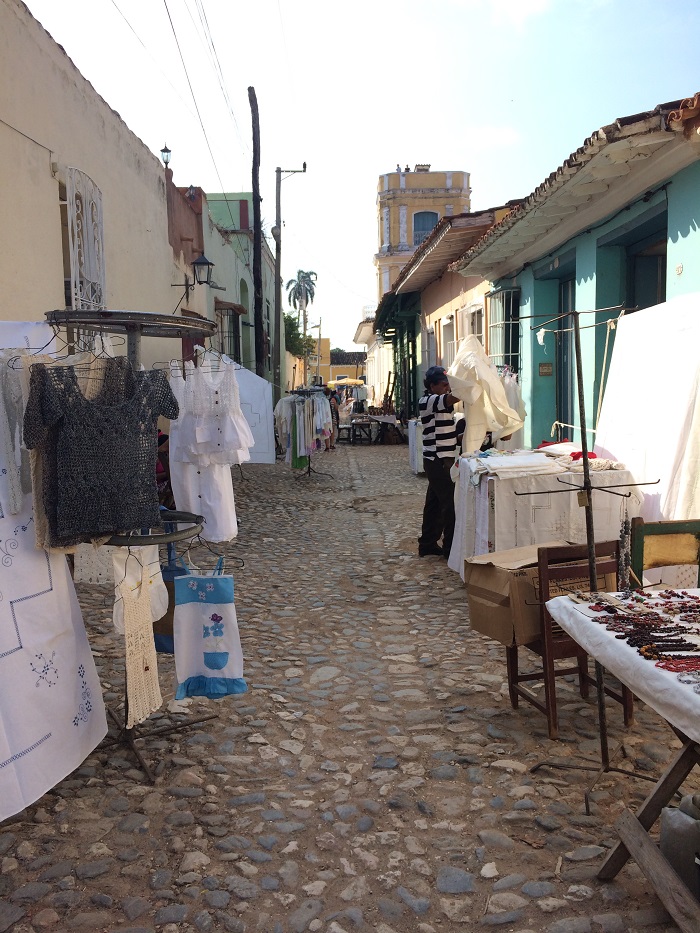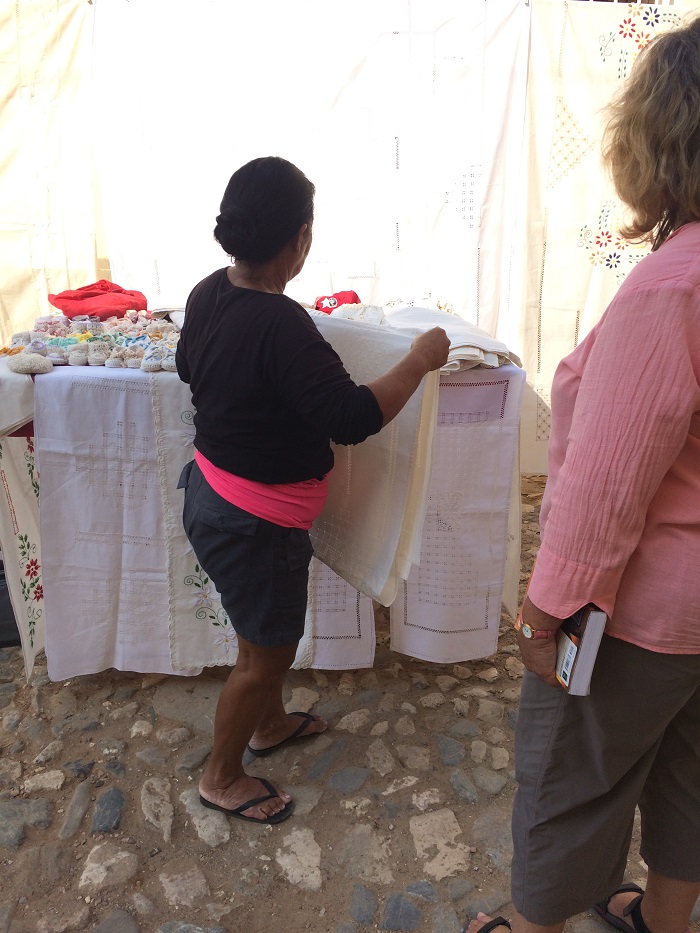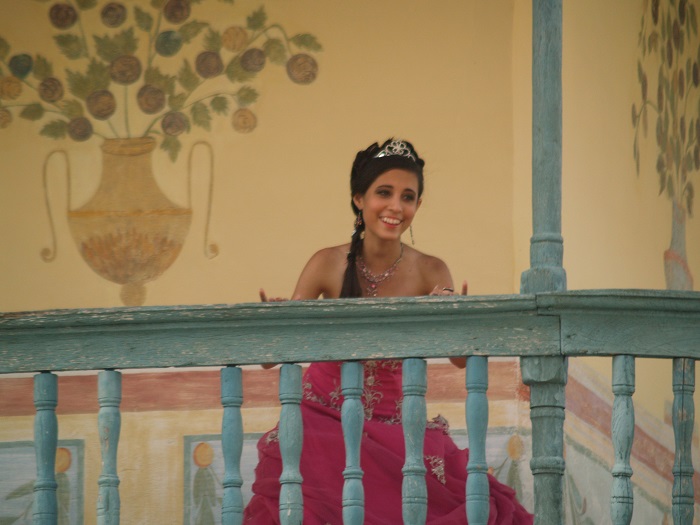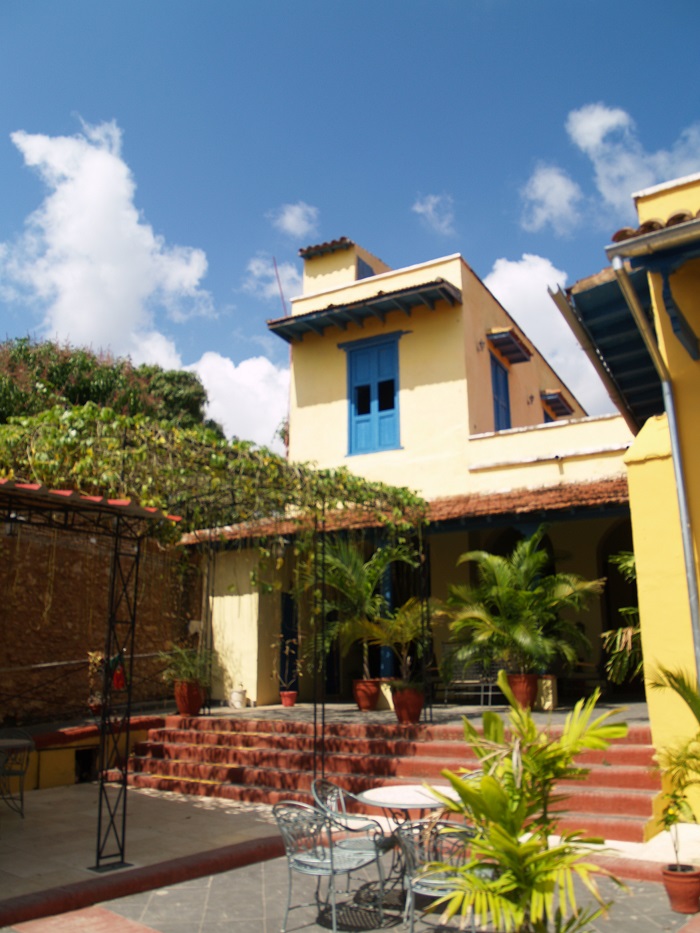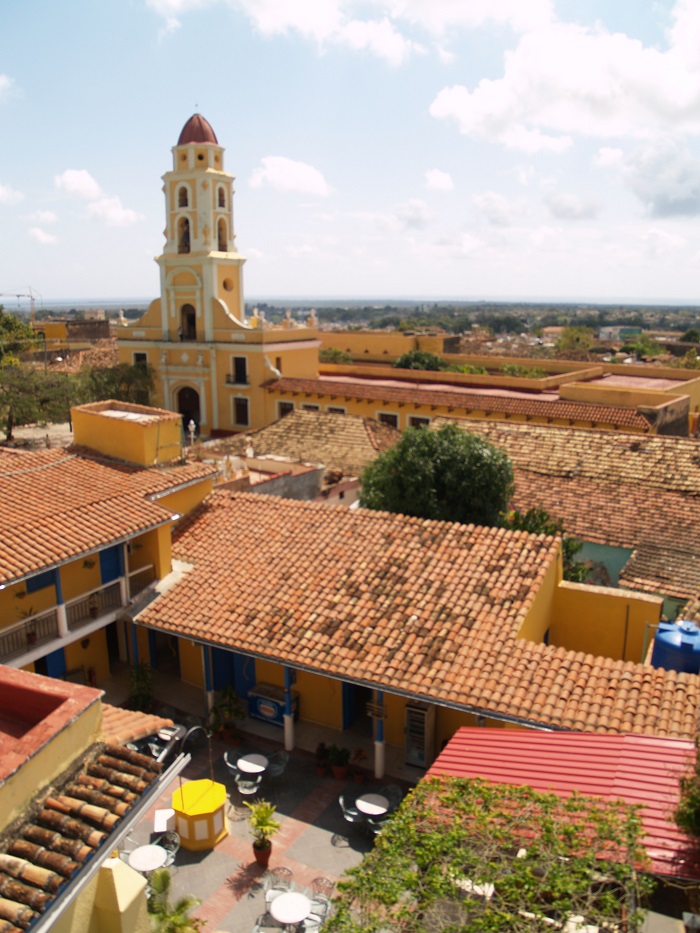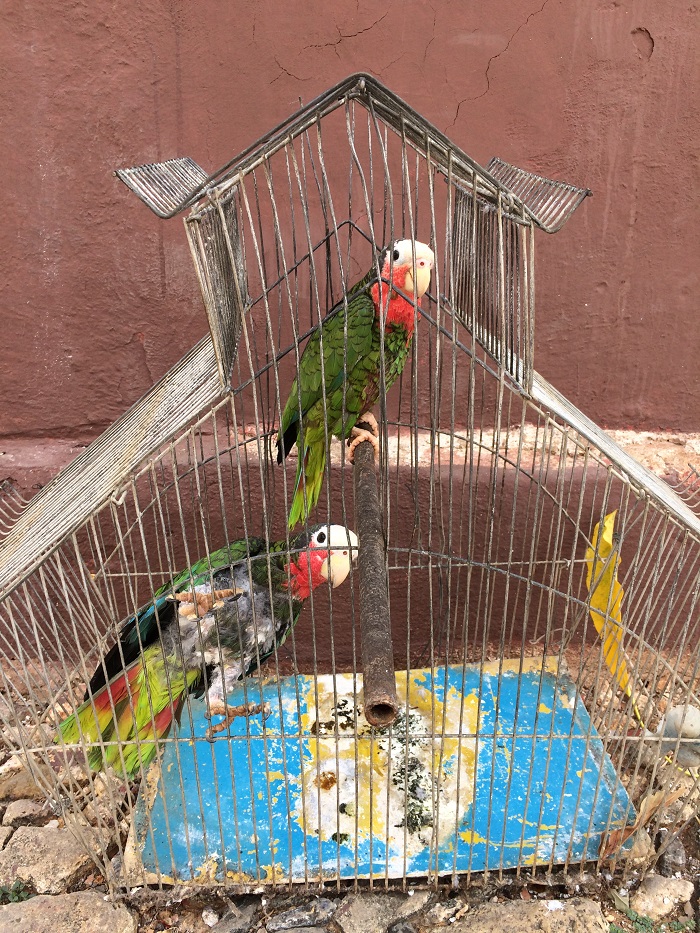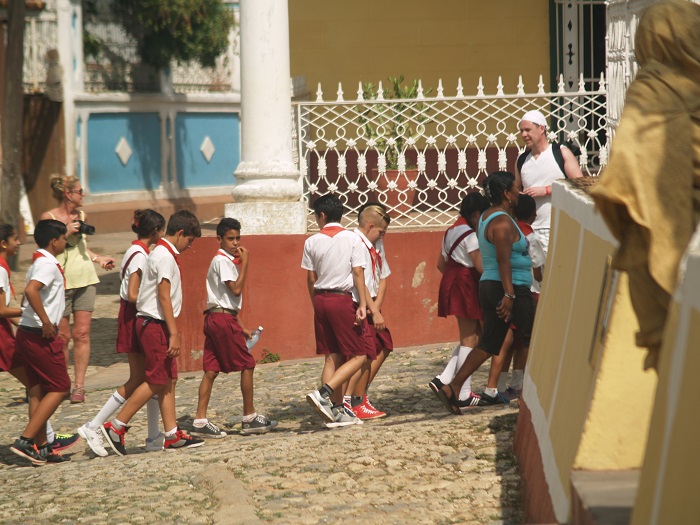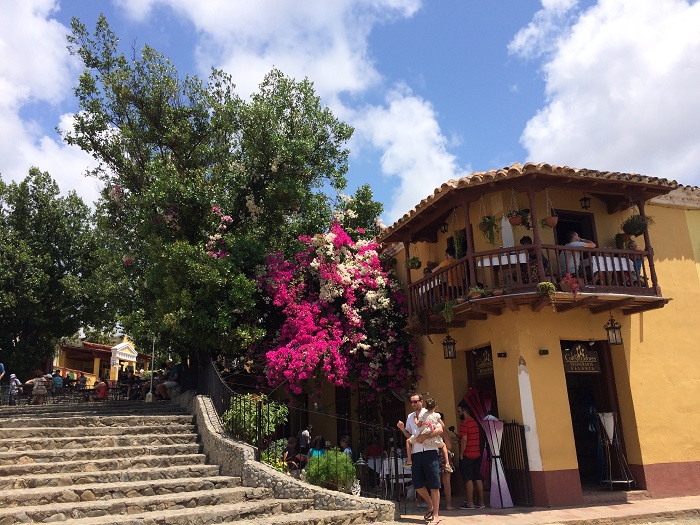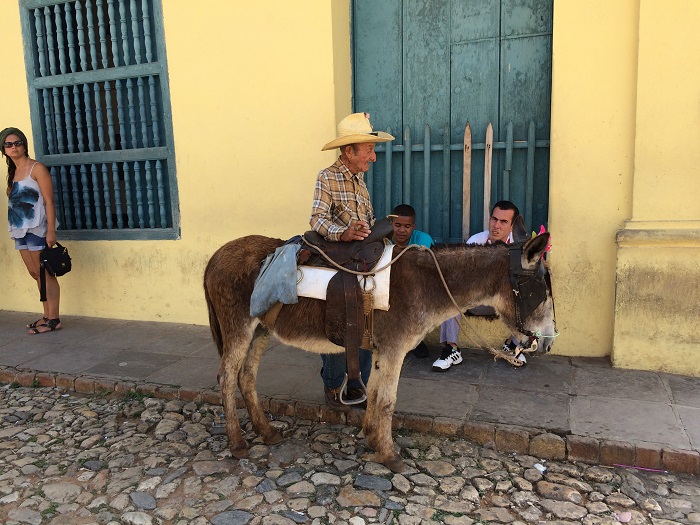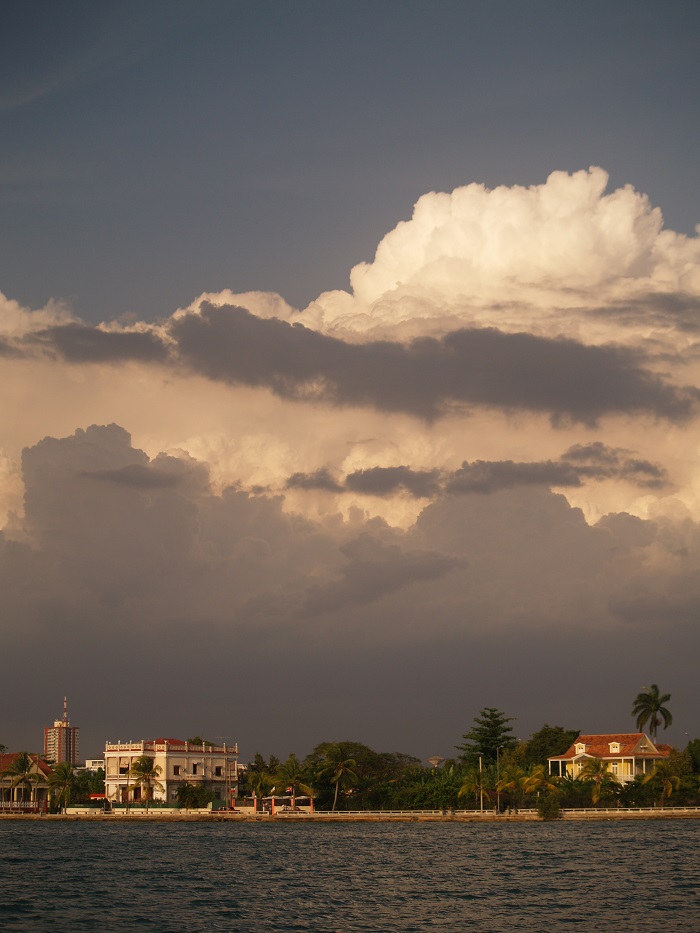The last day of March was our last day at anchor in Cienfuegos. We took a road trip to Trinidad! After asking for a bus schedule from the marina office, we were told that there is a bus to Trinidad three times a day: 8.30 am, 1pm, and 3.30pm. We decided to make a day of it and went ashore early to catch that first bus of the day. Not only was the ticket office closed, but also there was no bus to Trinidad until 12.30pm. None of the times we’d been given matched what we found at the bus station. Hmmm…
But there are Cubans who hang out at the station and try to make connections for people needing to get places. Before we were even aware that we were being watched we were put in touch with a driver who had a Cuban family (mother, father, teenage boy and adolescent girl) who also wanted to go to Trinidad. So they crammed in the backseat while Bob and I sat up front with the driver, and we were off! It cost $15 CUCs for us, so it was only a bit more than the bus would have been at $12 CUCs.
It was a beautiful drive too. Still early enough in the morning for cool breezes and low light in the hills all around us. We drove past the Cuban Botanical Gardens, which we learned is quite an impressive collection of plants. I wish we had known about it sooner in order to plan a visit. The area between Cienfuegos and Trinidad has a lot of farming, impressive orchards of mango and bananas and sugar cane fields. Some of the sugarcane was being harvested, not an easy job, and many of the mango trees were laden with fruit. I had no idea how many mangoes can grow on one tree! No wonder there are so many mangoes in the markets.
The most dramatic view we had on the trip to Trinidad was the annual migration of land crabs. We came around a bend to the sight of thousands of red-clawed, blue-bellied creatures completely blocking the road….all moving the same direction—inland from the coast. They were on their way back to their shelters and tunnels after spawning in the sea. I think the journey is several miles. We were behind a bus that was leaving a terrible swath of crushed crabs behind it, and our driver was quite adept at not hitting any crabs. The crabs knew they were in trouble and were all ready for a fight—pincers high in the air, snapping menacingly. They seemed to have no idea that it was not going to be a fair fight against buses and cars. I also have to tell you that the smell of crushed crab is terrible.
This is taken from internet since we did not get a photo of our own.

We’ve since learned that the crabs will scale anything that gets in their way on their journey to the ocean. They can scale houses and cars that happen to be in their path. Bob wanted to stop for a photograph, and the thought of the crabs climbing over our car, or worse, climbing over Bob himself, was beyond unnerving to me. We didn’t do it.
Coming into Trinidad made me forget all about the crabs. It was stunning! Trinidad was founded in 1514, and had a big celebration for their quincentennial in 2014. The city is a Unesco site with good reason. Against the harsh sun the soft pastels of the buildings is quite calming. It was a hot day, but there were plenty of shady spots to retreat and the pretty colors of the buildings were a relief to the eyes. We had started our tour with coffee in a small, sequestered part of the Plaza Mayor. We sat under a large canopy of vines that had interesting fruit hanging from them. I had a bit of a conversation with our waitress and learned that the name of this plant and its fruit is maracuya. It is edible as well as being medicinal. It made a wonderful bower to hide from the mid-morning hot sun.
Then we took a little tour of the central part of this city. And here I found much more evidence of textile handwork. There were lots of female street vendors selling crocheted tops and shawls and table linens done in what I am beginning to recognize as a traditional Cuban style of floral embroidery mixed with pulled thread embroidery. Handwork was everywhere, including in the local Museo del Arte. I was quite determined to buy a tablecloth and settled on one at the museum. The women who work in that part of the museum were very proud of these tablecloths and we all enjoyed taking them down from the walls to admire the work close up as I tried to settle on which one I would buy.
Here is one street of vendors selling handmade textiles.
A feast of wonderful choices!
(I will admit here that I’m going to give this table cloth to my new daughter in law….I’m certain that she will not see this. She and my son now have our large dining room table and buffet that had been Bob’s grandmother’s from the turn of the 20th century, but I still have all the linen damask cloths that came with that table. It’s time help them start a new collection of heirloom linens, before they get the original ones at some future point.)
Is this possibly Miss Trinidad posing at the entrance to the Museo de Arte?
We visited the Museo de Aquitectura where the entrance fee is $1 CUC per person, but if you take photographs there is an additional $5 CUC charge. It was an interesting museum, but we did not choose to pay for photography. There was a room of detailed displays on how the heavy mahogany doors were made and how they were hinged. The best part of the museum for me was the inner courtyard, lined in shady plants along the perimeter and in the center filled with about three dozen large urns planted in rose bushes. What a heavenly scene to find such a large collection of roses in bloom! Around the roses were some smaller pots of portulaca and vinca, and I learned that the Cubans call these plants something entirely different, although a rose is still a rosa.
Another inner courtyard in one of the historic buildings. We had just returned from visiting the rooftop.
Roof top views of Trinidad.
Birds in cages are everywhere. The cages hang on the outside of private apartments and in the public squares.
School children on a field trip in the Plaza Mayor.
We had lunch in the prettiest spot in all of Trinidad! Who cares about the food in a spot like this?—yet I have to say it one of our best lunches too—shrimp and lobster chunks over pasta, with gazpacho to start, and a mojito and sparkling water. We shared the pasta dish and had more than enough. I hated to leave. All the tables were set with At the table next to us we met a woman traveling alone from Malaysia who was celebrating her 40th birthday. We all agreed that we had found the prettiest restaurant in all of Trinidad.
We sat on the balcony at the table on the left. The Malaysian tourist is already sitting at the center table in the photo.
Local color.
In the late afternoon we headed to the bus station hoping to find another shared taxi. It took a bit of doing, but eventually we found a taxi driver who would take us back for $20 CUC, and no sharing. As we passed the area where the crabs had been there was nothing left but the ones who didn’t make it across the road.
Farewell, Cienfuegos, in the early morning light.
The next morning, April 1st, we left Cienfuegos to sail into the small archipelago of cayos called Cayos de Dios. It promised to be a good day for sailing with reasonably strong wind on the beam. Getting out of Cienfuegos harbor was quite rough for me, and then the sailing was also a bit ‘sporty,’ as Bob would say. So I ended up getting horribly sea sick, worse than I’ve been in decades. The day was not improved when we settled at Cayo Sal, although it was a better choice (read calmer) of anchorage than others along that route. At the end of the day, the wind was mild, from the east, but there was a wrap-around swell coming around the little cay that put all the boats rocking side to side. I was miserable! After a very tiresome night of rolling side to side, the next morning Bob tried putting a bridle on our anchor line and turning the boat sideways to the wind so that we’d be facing into the swell of waves. It was much better, but I never did fully recover.
Sunday (yesterday) we left Cayo Sal to head for Cayo Largo in the larger Archipelago de los Cannarreos. It was a mild sailing day, but I still could not shake my seasickness! I’ve always heard that everyone gets over their sickness after three days at sea, so I was rather disappointed not to shake it off. In the afternoon we chose to come all the way into the marina at Cayo Largo, and I immediately felt better. So, while I didn’t fit the old saying about three days at sea curing my seasickness, I did find another old saying to be quite true: “Nothing cures seasickness like sitting under an apple tree!” No apple trees here, but palm trees make a suitable substitute!
At this moment we are in the lap of luxury. This is a clean and up to date little marina, with lots of tourist amenities on shore. There was some kind of festival last night that I missed because I was just too tired to participate. There are bone-fishing boats here as well as dive and snorkel boats for hire. There are lots of bright white beaches to explore by dinghy. I think we will spend most of the week here. We are plugged in to electricity so we have our air conditioner running for the first time. It was quite wonderful last night, cool and dry, but this morning our electricity keeps shutting off now that more boats have arrived on this dock. I guess the electricity here is not meant for a full house of visitors.
One of the marina employees told us that the white sand here never gets hot, no matter how strong the sun is. We plan to check that out today.

